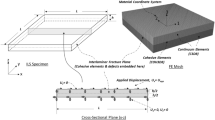Abstract
Laminates have a propensity to delaminate; the mathematical plane between adjacent plies offers a preferred path for crack propagation, irrespective of the nature of the stress field that gives rise to the elastic strain energy released. This is because the plane between plies is characterised by a specific fracture surface energy significantly lower than those for internal surfaces that intersect fibres. In the second of his two classical publications on fracture, A.A. Griffith showed how crack rotation in two-dimensional stress fields occurs. This suggests how, in a laminate, pre-existing flaws are able to seek out the plane of lamination; here, crack rotation under the influence of, for example, shear stress is examined in the context of laminates designed for use in aerospace. One physical consequence of Griffith’s calculation is the prediction of crack propagation in elastic solids subjected to bidimensional compression with strongly unequal principal stresses. A simple bidimensional compression rig has been devised to investigate this prediction. To obviate the risk of delamination, it will be necessary to move away from anisotropic lay-ups, and further develop three-dimensional weaves and methods for weaving three-dimensional weaves. A method whereby a three-dimensional fibre weave, which has cubic symmetry and no zero-valued shear moduli, might be weaved is outlined.










Similar content being viewed by others
References
Inglis CE (1913) Trans Inst Nav Archit 55:219
Griffith AA (1924) The theory of rupture. In: 1st international conference on applied mechanics, Delft, pp 55–63
Orowan E (1948/1949) Rep Prog Phys 12:185. doi:https://doi.org/10.1088/0034-4885/12/1/309
Ashbee KHG (1991) Bidimensional compression. In: Sir Charles Frank, OBE, FRS: an eightieth birthday tribute. Adam Hilger, pp 353–368
Ashbee KHG (1998) Three-dimensional fiber weave with cubic symmetry and no zero-valued shear moduli, US Patent Number 5,804,277
Frank FC (1963) ASM Seminar on “Metal Surfaces, Structure, Energetics and Kinetics”, Ch. 1. American Society for Metals
Acknowledgements
The author gratefully acknowledges correspondence with Dr J. C. Gill, latterly of Bristol University, on the physics of electromagnetic wave propagation by fibre-reinforced materials. The mathematical equations and the figures were prepared with the assistance of T. L. Ashbee.
Author information
Authors and Affiliations
Corresponding author
Rights and permissions
About this article
Cite this article
Ashbee, K.H.G. On the propensity of laminates to delaminate. J Mater Sci 43, 6599–6603 (2008). https://doi.org/10.1007/s10853-008-2628-8
Received:
Accepted:
Published:
Issue Date:
DOI: https://doi.org/10.1007/s10853-008-2628-8




